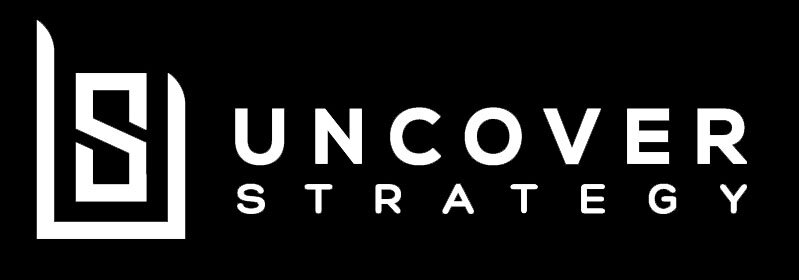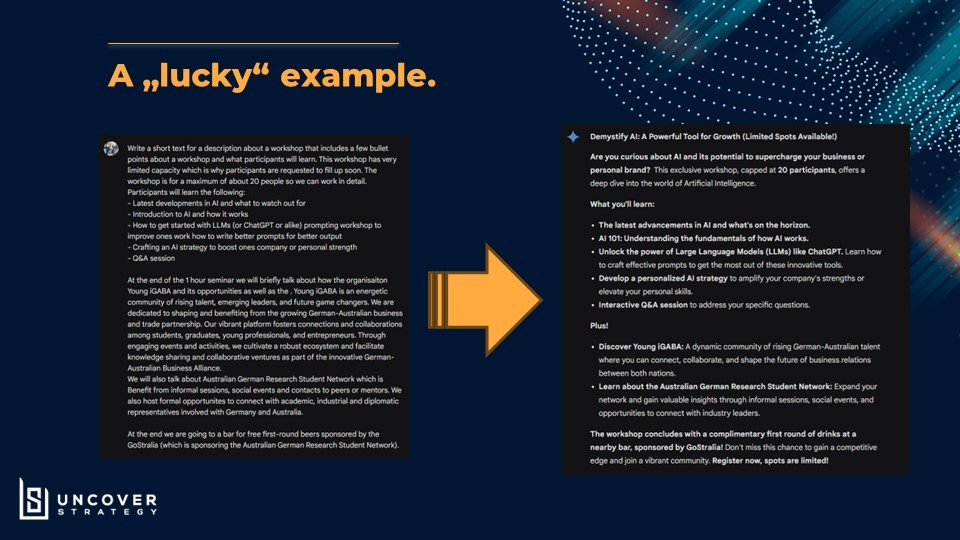Boost Your GenAI Results with 2 Simple Prompt Additions: A Workshop Recap
Input matters.
A few days ago, I hosted a beginner's session on starting to work with AI.
Why?
In conversations, I hear many managers and business owners struggle to realise the benefits of using AI tools. I also wrote a blog post on this recently.
An idea hit me: What would I want to know about AI if I knew almost nothing? How could I even get started quickly for immediate results?
To get started as a small or medium business owner, manager, or employee, one of the quickest ways, in my opinion, is to actually get started. There are no shortcuts. Start using the tools available to you today.
Often, this means starting with easily accessible GenAI language models such as ChatGPT.
How can you improve the quality of your output in ChatGPT, Gemini or alike - in the shortest amount of time possible?
Given the positive feedback at the event, I decided to condense my 2 top tips to improve your prompts (one way to get hands on it, fast) into today’s blog post.
Want to learn more about achieving results fast by doing it all yourself? Register now for the next webinars in July (register here for Europe, register here for Asia) (offered online only), or schedule a free advice session with me.
The Problem with Your Prompt.
Why would I care about improving my prompt?
To achieve consistently better outputs.
Consider the example below. You may get a good result the first time you instruct the GPT to provide you with output that you need to adjust only slightly before using it for whatever purpose you want.
Dumping all information into the GPT of my choice, I could re-use the output almost immediately without minor changes (and, of course, only after cross-checking the actual content).
Source: Simon Beuse, 2024
However, have you experienced it before that your input is just not suitable or you’d have to change too many things to make it work?
If you do not write good instructions, GenAI does not have sound or sufficient instructions and information on what to do.
Garbage in, garbage out, right?
It can be dangerous to dispose of your garbage in Kangaroo Island, Australia.
Source: Simon Beuse, Kangaroo Island (South Australia), 2021
With this in mind, let’s see how we can reduce the garbage you and I put into our prompts and improve your prompt quality quickly.
What is Prompt Engineering?
In line with a recent blog post by McKinsey, Prompt Engineering is important for consistent GenAI output.
“Prompt engineering is the practice of designing inputs for AI tools that will produce optimal outputs.”
Plus, it also sets limits on what information you need to provide.
So you need to give the GPT more information, but not excessive amounts. After all, you don’t want to type up 33 pages of instructions and waste 40 hours of your precious time. You could watch your favourite Netflix show twice within that time!
Below is an excerpt of two of the main building blocks that can enhance your prompts, curated by Jeff Su (check out his super intuitive guides here).
For your convenience, I picked the two I found most influential when experimenting and running through the workshop content with my participants: context and exemplars.
Prompt Addition #1: Context
One of the most powerful things you can do to improve your prompt is to provide more context.
Why?
You want to limit the wide range of outputs from ChatGPT while avoiding writing too much (otherwise, where is your productivity gain?). Here are three questions to ask yourself:
What is the user’s background?
What does success look like?
What environment are they in?
Here is an example:
❌ Worse: "Generate event ideas for a mountain bike event."
✅ Better: "I am an event planner looking to create a unique and exciting mountain bike event name. We are hosting the event near a lake surrounded by flatlands, so there are few hills or other interesting features. Generate 10 unique event titles for mountain bike events."
Prompt Addition #2: Exemplar
Another very powerful addition you can make to your prompt is providing an exemplar. Some research on LLMs has shown that exemplars improve accuracy (https://learnprompting.org, 2023).
One example (not exemplar!) my PhD colleagues are exceptional: celebrating my birthday and ensuring I take a break from research.
Source: Simon Beuse, 2024
What’s the difference between an example and an exemplar?
An example shows how something works, while an exemplar sets a standard to follow.
Imagine you are looking to improve your resume and want to re-write bullet points in the usual “HR recruitment way”.
Do this:
❌ Worse (only providing the task): "Re-write these bullet points using this structure: I accomplished X by the measure Y that resulted in Z."
✅ Better (providing the example): "For example: „Lowered IT system downtime by 5% by implementing always-online backup systems, which translates to 1000 hrs of worktime saved per year“.
Conclusion
To summarise, adding context and an exemplar will dramatically increase the output prompt quality. However, we discussed many more building blocks in the seminar, such as context, task, persona, exemplar, tone, and format. If you’d like to learn more about these, sign up for the next workshop.
REGISTER NOW! 👇
Workshop 1 - [EUROPE REGION]
July 16th @ 9 AM Berlin time (CEST) (click to register)
Workshop 2 [ASIA REGION]
July 18th @ 6 PM Brisbane time (AEST) (click to register)
Because of the positive feedback, I will offer this again in English for European and German time zones. We will also discuss briefly why you need an AI strategy, explaining the importance of having an AI strategy, the competitive advantage, holistic approach, and security considerations in AI strategy.
You did the first step to write better prompts by considering these two elements.
Want to learn more?
For a personalised consultation on how AI can elevate your overall business strategy or how to get started, reach out to us here at Uncover Strategy. Next to reading our free blog, we offer free discovery calls to help you uncover the potential of AI in your business. Take the first step towards transformation today.
Note: Some of the editing for this content has been assisted by AI technology to enhance efficiency. Rest assured that all information provided remains thoroughly vetted and accurate.









